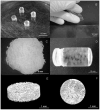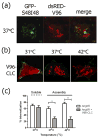Engineering structure and function using thermoresponsive biopolymers
- PMID: 26112277
- PMCID: PMC4732732
- DOI: 10.1002/wnan.1350
Engineering structure and function using thermoresponsive biopolymers
Abstract
Self-assembly enables exquisite control at the smallest scale and generates order among macromolecular-building blocks that remain too small to be manipulated individually. Environmental cues, such as heating, can trigger the organization of these materials from individual molecules to multipartixcle assemblies with a variety of compositions and functions. Synthetic as well as biological polymers have been engineered for these purposes; however, biological strategies can offer unparalleled control over the composition of these macromolecular-building blocks. Biologic polymers are macromolecules composed of monomeric units that can be precisely tailored at the genetic level; furthermore, they can often utilize endogenous biodegradation pathways, which may enhance their potential clinical applications. DNA (nucleotides), polysaccharides (carbohydrates), and proteins (amino acids) have all been engineered to self-assemble into nanostructures in response to a change in temperature. This focus article reviews the growing body of literature exploring temperature-dependent nano-assembly of these biological macromolecules, summarizes some of their physical properties, and discusses future directions.
© 2015 Wiley Periodicals, Inc.
Figures






Similar articles
-
Biopolymers as a flexible resource for nanochemistry.Angew Chem Int Ed Engl. 2013 Jan 21;52(4):1096-108. doi: 10.1002/anie.201206943. Epub 2012 Dec 13. Angew Chem Int Ed Engl. 2013. PMID: 23239557 Review.
-
Biopolymer-based materials: the nanoscale components and their hierarchical assembly.Curr Opin Chem Biol. 2007 Apr;11(2):214-9. doi: 10.1016/j.cbpa.2007.01.677. Epub 2007 Feb 12. Curr Opin Chem Biol. 2007. PMID: 17293158 Review.
-
Principles of nanostructure design with protein building blocks.Proteins. 2007 Jul 1;68(1):1-12. doi: 10.1002/prot.21413. Proteins. 2007. PMID: 17407160 Review.
-
Block copolymer systems: from single chain to self-assembled nanostructures.Langmuir. 2010 Oct 19;26(20):15734-44. doi: 10.1021/la100641j. Langmuir. 2010. PMID: 20364859 Review.
-
Building DNA nanostructures for molecular computation, templated assembly, and biological applications.Acc Chem Res. 2014 Jun 17;47(6):1778-88. doi: 10.1021/ar500023b. Epub 2014 Apr 10. Acc Chem Res. 2014. PMID: 24720350
Cited by
-
Gellan gum conjugation with soy protein via Maillard-driven molecular interactions and subsequent clustering lead to conjugates with tuned technological functionality.Food Chem X. 2022 Aug 8;15:100408. doi: 10.1016/j.fochx.2022.100408. eCollection 2022 Oct 30. Food Chem X. 2022. PMID: 36211769 Free PMC article.
-
Self-assembly in elastin-like recombinamers: a mechanism to mimic natural complexity.Mater Today Bio. 2019 May 20;2:100007. doi: 10.1016/j.mtbio.2019.100007. eCollection 2019 Mar. Mater Today Bio. 2019. PMID: 32159144 Free PMC article. Review.
-
Synergy between Laminin-Derived Elastin-like Polypeptides (LELPs) Optimizes Cell Spreading.Biomacromolecules. 2024 Jul 8;25(7):4001-4013. doi: 10.1021/acs.biomac.4c00144. Epub 2024 May 30. Biomacromolecules. 2024. PMID: 38814168 Free PMC article.
-
Photothermal-modulated drug delivery and magnetic relaxation based on collagen/poly(γ-glutamic acid) hydrogel.Int J Nanomedicine. 2017 Mar 31;12:2607-2620. doi: 10.2147/IJN.S133078. eCollection 2017. Int J Nanomedicine. 2017. PMID: 28408827 Free PMC article.
-
Responsive Hybrid (Poly)peptide-Polymer Conjugates.J Mater Chem B. 2017;5(42):8274-8288. doi: 10.1039/C7TB02199B. Epub 2017 Oct 6. J Mater Chem B. 2017. PMID: 29430300 Free PMC article.
References
-
- Mi P, Kokuryo D, Cabral H, Kumagai M, Nomoto T, Aoki I, Terada Y, Kishimura A, Nishiyama N, Kataoka K. Hydrothermally synthesized PEGylated calcium phosphate nanoparticles incorporating Gd-DTPA for contrast enhanced MRI diagnosis of solid tumors. J Control Release. 2014;174:63–71. - PubMed
Publication types
MeSH terms
Substances
Grants and funding
LinkOut - more resources
Full Text Sources
Other Literature Sources

